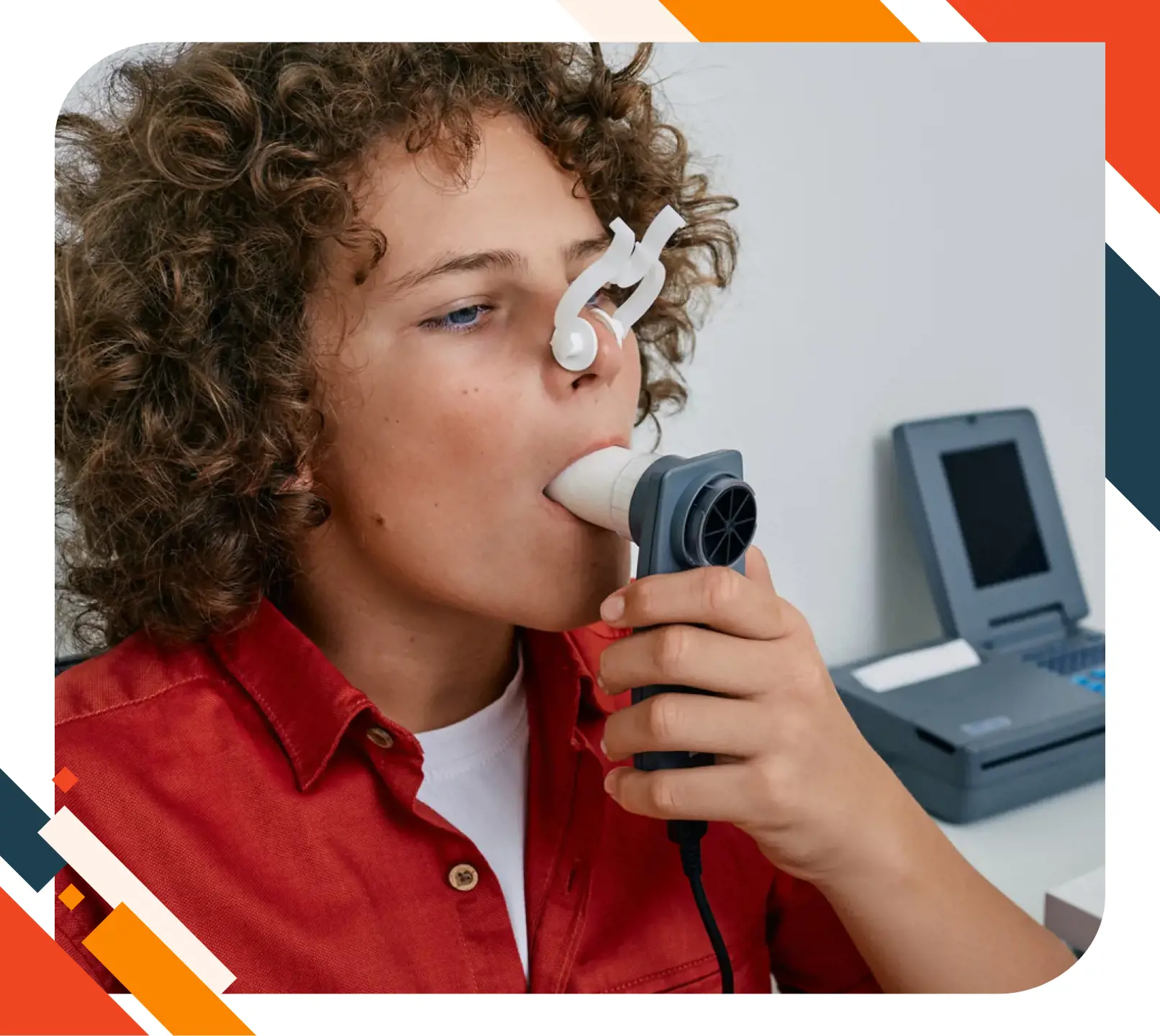Key takeaways:
-
Thunderstorm asthma occurs during storms in high-pollen seasons, affecting the lower airways.
-
Ryegrass pollen and stormy weather are key triggers, with asthma and hay fever sufferers most at risk.
-
Symptoms include wheezing, coughing, shortness of breath, blue lips, and confusion.
-
Monitor pollen alerts, use preventer medication, and update asthma action plans to reduce risks.
-
Act quickly with first aid, use a reliever inhaler, and call Triple Zero (000) for severe symptoms.
Thunderstorm asthma is a severe health condition triggered by specific weather events, particularly during Australia’s grass pollen season,which typically spans from October to December. Understanding its causes and prevention is important to protecting yourself and those around you. This guide explains thunderstorm asthma, its causes, how it differs from regular asthma and hay fever, and strategies to manage and prevent it.
What is Thunderstorm Asthma?
It occurs when storms break pollen grains, especially from ryegrass, into tiny particles. These microscopic fragments can penetrate deep into the lungs, causing sudden, severe asthma symptoms.
Unlike regular asthma, which may have various triggers, thunderstorm asthma is specifically associated with high pollen levels and stormy weather conditions. Hay fever primarily affects the nasal passages and eyes, whereas thunderstorm asthma impacts the lower airways, leading to breathing difficulties that may require immediate medical attention.
Causes of Thunderstorm Asthma
The Role of Thunderstorms
Storms create unique weather conditions, including strong winds and lightning. These rapid changes in temperature and humidity can cause pollen grains to absorb moisture and burst into smaller particles. These particles become airborne and are easily inhaled, and can trigger asthma in susceptible individuals.
Pollen and Allergens
Ryegrass pollen, abundant in Australia, plays a significant role. Thunderstorms break down these grains, creating allergenic fragments easily inhaled by sensitive individuals, leading to severe asthma symptoms.
Symptoms of Thunderstorm Asthma
Recognising Symptoms
Early recognition of symptoms is vital for prompt treatment.
Mild to Moderate Symptoms:
-
Wheezing: A whistling or squeaky sound when breathing, indicating narrowed airways.
-
Shortness of breath: Difficulty catching your breath, making daily activities challenging.
-
Chest tightness: A feeling of heaviness or pressure in the chest, common during asthma attacks.
-
Coughing: Persistent and , often worse at night or early morning.
Spotting symptoms early helps prevent severe asthma attacks. Ignoring them can worsen your condition and may lead to hospitalisation. Acting quickly allows you to use your reliever, follow your asthma plan, and get help if needed, avoiding serious complications.
Severe Symptoms
-
Rapid breathing: Struggling to take in enough air, with rapid or shallow breaths.
-
Severe shortness of breath: Speaking in broken sentences or being unable to speak due to shortness of breath.
-
Blue lips or face: A sign of low oxygen levels in the blood.
-
Dizziness or confusion: Caused by reduced oxygen flow to the brain.
If these symptoms appear, call Triple Zero (000) immediately for emergency medical assistance.
Risk Factors for Thunderstorm Asthma
Who is at Risk?
-
Those with mild to severe asthma are more likely to experience thunderstorm asthma.
-
Hay fever sufferers, especially during peak pollen seasons, face higher risks.
-
Sensitivity to ryegrass pollen, common in Australia, increases vulnerability.
-
Poorly controlled symptoms or lack of preventive measures heighten the chances of severe attacks.
-
People exposed to outdoor air during thunderstorms, such as gardeners or construction workers, are at increased risk.
-
People in specific geographic areas like Melbourne and South East Australia, with high ryegrass pollen levels, face greater risk.
Thunderstorm Asthma in Melbourne
South East Australia, especially Melbourne, experiences frequent thunderstorm asthma events due to high ryegrass pollen levels. Tools like VicEmergency provide real-time warnings to help manage risks. Myhealth clinics across Melbourne offer specialised asthma care.
Preventing Thunderstorm Asthma
Monitoring Thunderstorm Asthma Warnings
Monitoring weather and pollen forecasts is crucial during high-risk periods. Use platforms like Melbourne Pollen and VicEmergency for real-time alerts. On high-risk days, stay indoors, keep windows closed, and avoid outdoor activities. Ensure your reliever inhaler is on hand and your asthma action plan is up to date. If you are sensitive to pollen, consider using an air purifier indoors. Proactively monitoring these warnings can help reduce the risk of asthma attacks and keep your symptoms under control.
Medications and Treatment
Two main types of medications help manage thunderstorm asthma:
-
Preventers: These, like inhaled corticosteroids, reduce airway inflammation and sensitivity to triggers such as pollen. They should be used daily, even when you feel fine, to control asthma over the long term.
-
Relievers: Short-acting bronchodilators (e.g., salbutamol) provide quick relief during an asthma attack by opening up the airways. Use them when you experience symptoms like wheezing or shortness of breath.
Creating an Asthma Action Plan
A personalised asthma action plan is important for managing thunderstorm asthma. It helps you know exactly what to do for daily care and during an asthma attack.
Work with your GP to create a plan that includes:
-
Clear steps for using preventers and relievers.
-
Monitor when symptoms occur and their severity.
-
Know when to use your inhaler and when to seek medical help.
-
Identify personal triggers and how to avoid them.
Regularly update your plan with your GP, especially during high-risk periods, to ensure it stays effective and addresses your current needs.
Hayfever Treatment Plan
Effectively managing hay fever is important to reduce the risk of thunderstorm asthma by controlling airway inflammation and sensitivity to pollen. A treatment plan may include:
-
Antihistamines: Help block allergic reactions and relieve symptoms like sneezing and itching.
-
Nasal sprays: Steroid or decongestant sprays reduce congestion and inflammation, improving airflow.
-
Eye drops: Antihistamine eye drops can help relieve eye irritation.
Consult your GP for the right treatment and review your plan regularly, especially during high pollen seasons, to help prevent asthma triggers and manage symptoms.
Managing Thunderstorm Asthma Attacks
Immediate Steps to Take & Preventative measures
During a thunderstorm asthma attack, stay calm and follow these steps:
-
Sit upright to make breathing easier.
-
Use Your Reliever Inhaler, as prescribed with a spacer.
-
If symptoms don’t improve in 20 minutes, take another dose.
-
If symptoms persist, follow the steps in your plan.
-
If symptoms worsen, call emergency services (Triple Zero 000).
Asthma First Aid
-
Sit upright
-
Administer 4 puffs of reliever inhaler, with 4 breaths after each puff
-
Wait 4 minutes
-
If no improvement, repeat steps 2 and 3.
-
If still no improvement, call Triple Zero (000).
Acting quickly with proper first aid can help manage symptoms and prevent further complications. For detailed guidance, refer to the National Asthma Council Australia’s resources.
When to Seek Emergency Help
Seek emergency medical attention if:
-
If you can’t speak full sentences, feel breathless even at rest, or experience rapid or shallow breathing.
-
If your reliever inhaler hasn’t improved symptoms after 10–15 minutes, or you need to use it more than once every 3 hours.
-
This can be a sign of insufficient oxygen, requiring immediate medical help.
When Calling Emergency Services:
-
Be clear and precise about where you are.
-
Let the operator know your breathing difficulties, whether the inhaler is working, and if symptoms are worsening.
-
Follow any instructions given and remain calm until help arrives.
Where to seek medical help
It’s important to visit your GP to ensure you’re fully prepared for upcoming thunderstorm asthma events. Your GP can help update your asthma action plan, adjust your hayfever treatment, and review your medications to ensure they're suitable for your current needs.
Myhealth Clinics in NSW, VIC, and QLD have experienced GPs available to help manage and treat thunderstorm asthma. They can assist with personalising your treatment plan, providing ongoing support, and ensuring you're properly protected during high-risk pollen seasons. Regular check-ups with your GP will keep you on track and reduce the risk of severe asthma episodes.
Further Resources
Government Pollen Counts
Staying informed about pollen counts is important for managing asthma and hayfever, especially during high-risk seasons like September to October. Government websites and local tools provide real-time pollen information and weather conditions, helping you monitor risks and take preventive measures.
-
Melbourne Pollen: Provides daily pollen counts for Melbourne, helping you track allergy risk in real-time.
-
Sydney Pollen: Offers pollen count updates for Sydney, allowing you to stay ahead of potential asthma triggers.
-
VicEmergency: A government resource for emergency warnings and weather conditions in Victoria, including pollen alerts during the pollen season.
By using these resources, you can stay informed and make decisions to avoid exposure during high-risk periods, such as staying indoors on days with high pollen levels.
References:
- Melbourne Pollen. Melbourne Pollen Counts. Retrieved from https://www.melbournepollen.com.au/
- Sydney Pollen. Sydney Pollen Counts. Retrieved from https://www.sydneypollen.com.au/
- VicEmergency.Emergency Victoria - Thunderstorm Asthma Alerts. Retrieved from https://www.emergency.vic.gov.au/respond/
- Health Victoria.Thunderstorm Asthma Multicultural Resources. Retrieved from https://www.health.vic.gov.au/environmental-health/thunderstorm-asthma-multicultural-resources
- Health NSW.Protect Against Thunderstorm Asthma. Retrieved from https://www.health.nsw.gov.au/environment/air/Pages/protect-thunderstorm-asthma.aspx
- National Asthma Council Australia. Thunderstorm Asthma Factsheet. https://www.nationalasthma.org.au/living-with-asthma/resources/patients-carers/factsheets/thunderstorm-asthma
- University of Melbourne. Melbourne Pollen Count and Forecast. https://www.melbournepollen.com.au
- Asthma Australia. Thunderstorm Asthma: Information for Patients. https://www.asthma.org.au
- Herald Sun. Got hayfever? Here's why you're in for a really rough summer. Published 2024. https://www.heraldsun.com.au/news/victoria/got-hayfever-heres-why-youre-in-for-a-really-rough-summer
- Victorian State Government. VicEmergency: Emergency Warnings and Alerts. https://emergency.vic.gov.au
- University of Sydney. Sydney Pollen Count and Forecast. https://www.sydneypollen.com.au













































